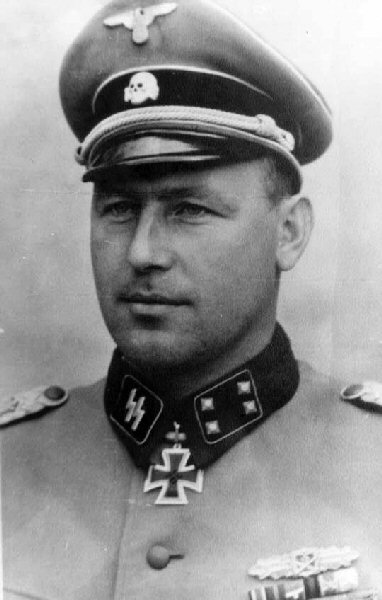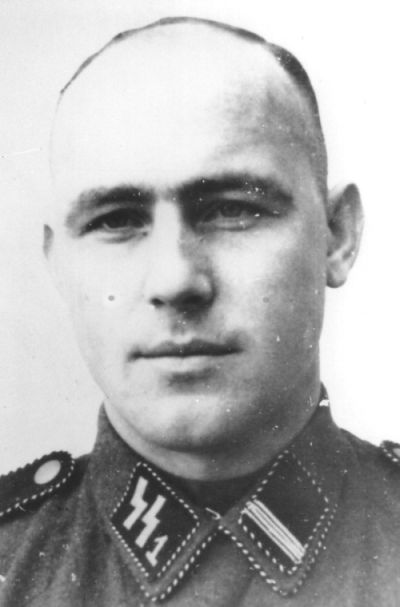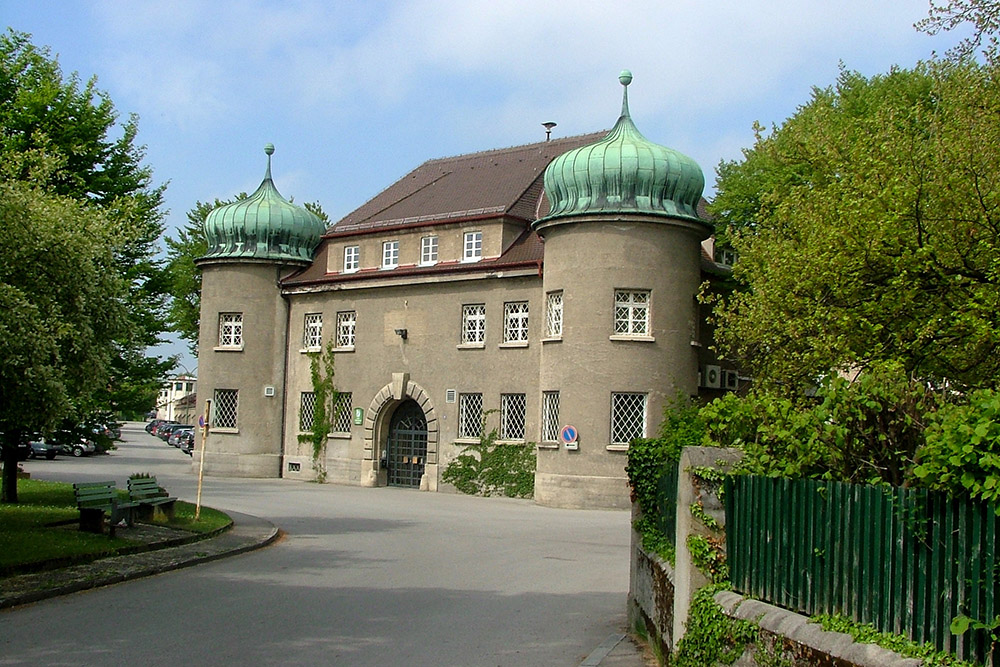Knittel, Gustav (Waffen SS)
- Date of birth:
- November 27th, 1914 (Neu-Ulm/Danube/Bavaria, Germany)
- Date of death:
- June 30th, 1976 (Ulm/Bavaria, Germany)
- Service number:
- SS-Nr.: 111.507 // NSDAP-Nr.: 2.242.615
- Nationality:
- German
Biography
Promotions:
01.09.1936: SS-Rottenführer
01.08.1937: SS-Unterscharführer
09.11.1938: SS-Untersturmführer
09.11.1939: SS-Obersturmführer
09.11.1941: SS-Hauptsturmführer
24.04.1943: SS-Sturmbannführer
Career:
15.04.1933: joined the SS
01.05.1933: joined the NSDAP
00.08.1933: joined the SS, 79. SS-Standarte, Ulm
00.00.1933: Nürnberg Partei-Tag
00.03.1934: applied for a position in the Reichswehr and rejected
00.10.1934: joined the SS-Standarte 'Deutschland', SS-Verfügungstruppe, Ellwangen
01.10.1937: SS-Junker, SS-Junkerschule Bad Tölz
28.07.1938: promoted to SS-Standartenoberjunker
00.08.1938: Zugführer-Lehrgang, SS camp Dachau
00.11.1938: SS-Ustuf, SS-Regiment 'Deutschland' - campaign in the Sudetes
26.08.1939-00.05.1940: SS-Ustuf, Adjutant, SS-Kradschützen-Ersatz-Bataillon 'Ellwangen'
15.05.1940-19.08.1940: SS-Ostuf, Zugführer, 15. Kompanie, SS-LAH Division - campaign in France
19.06.1940: SS-Ostuf, WIA to the leg at Saint-Pourçain-sur-Sioule and sent to Lazarett Troyes then in SS hospital in Hohenlychen
19.08.1940: SS-Ostuf, Führer, 4. schwere Kompanie, SS-Aufklärungs-Abteilung, LSSAH
00.04.1941: SS-Ostuf, campaign in the Balkans and in Greece - Operation Marita
00.06.1941: SS-Ostuf, campaign in Russia - Zhytomyr - Operation Barbarossa
11.07.1941: SS-Ostuf, WIA north of Marchlewsk to the right armpit and sent to SS-Lazarett Hohenlychen
00.08.1941: SS-Ostuf, SS-KL Dachau
09.11.1941: SS-Hstuf, Führer, 4. schwere Kompanie, SS-Aufklärungs-Abteilung, LSSAH - Sultan-Sali, battle for Rostov
27.11.1941-01.12.1941: SS-Hstuf, Führer, SS-Kampfgruppe - Taganrog
00.03.1942-00.04.1943: SS-Hstuf, Führer, 3. Kompanie, SS-Aufklärungs-Abteilung, LSSAH - Sennelager then Normandy then Russia
02.02.1943: SS-Hstuf, Battle of Kharkov - distinguished himself at Shevchenkove
13.02.1943: SS-Hstuf, led the counter-attack direction Alexejewka
15.02.1943: SS-Hstuf, recconnaissance direction Bereka - WIA by a bullet in his thigh and evacuated
16.02.1943: SS-Hstuf, hospitalized in Krasnohrad
18.02.1943: SS-Hstuf, Feldlazarett in Poltava
22.04.1943-00.08.1944: SS-Stubaf, Kdr, SS-Aufklärungs-Abteilung 1, 1. SS-Panzer-Division LSSAH
11.07.1943: SS-Stubaf, WIA at Kursk but stayed with the troops
00.12.1943: SS-Stubaf, fightings in Turbovka and at Divin, Ukraine
13.03.1944: SS-Stubaf, secured Bowenez Pocket between Ternopil and Proskurov
30.03.1944-01.04.1944: SS-Stubaf, defence of Hill 300 south of Andrejewka
00.06.1944: SS-Stubaf, sent to refit in Turnhout, Belgium then sent to Normandy
00.11.1944-12.12.1944: SS-Stubaf, Kdr, SS-Feld-Ersatz-Bataillon LSSAH
13.12.1944: SS-Stubaf, Führer, Schnelle Gruppe 'Knittel', SS-Aufklärungs-Abteilung 1, 1. SS-Panzer-Division LSSAH, I. SS-Panzerkorps - Euskirchen, Operation Wacht am Rhein
16.12.1944: SS-Stubaf, quick advance through Hallschlag, Manderfeld, Holzheim, Honsfeld, Heppenbach, Amel and Born
17.12.1944: SS-Stubaf, a scouting party of Schnelle Gruppe 'Knittel' murdered 11 African-American soldiers of the 333rd Artillery Battalion in Wéreth
18.12.1944: SS-Stubaf, crossed the Amblève River bridge in Stavelot at noon to contact SS-Kampfgruppe 'Peiper' in La Gleize
19.12.1944: SS-Stubaf, command post in the Antoine Farm west of Stavelot - his battalion murdered civilians in Trois-Ponts, Parfondruy, Renardmont and Stavelot but was trapped between Stavelot, Coo and Trois-Ponts
20.12.1944-22.12.1944: SS-Stubaf, heavy fightings region Ster, Petit-Spai, Trois-Ponts and Stavelot
25.12.1944: SS-Stubaf, retreated direction Wanne then to the Bastogne area
31.12.1944: SS-Stubaf, WIA and sent to a Lazarett when his command post was air bombed
05.01.1946: SS-Stubaf, captured by the US Counter Intelligence Corps in Neu-Ulm
00.03.1946: transferred to Schwäbisch Hall for the Malmedy massacre trial
16.07.1946: sentenced to life imprisonment for the murder of eight American prisoners of war at the command post of his heavy company near Petit-Spay, east of Trois-Ponts the 21.12.1944
00.03.1948: sentence reduced to 15 years imprisonment
00.05.1948: sentence reduced to 12 years imprisonment
07.12.1953: released
Do you have more information about this person? Inform us!
- Rank:
- SS-Standartenoberjunker
- Unit:
- Zugführer, 6. Sturm, SS-Regiment 'Deutschland'
- Awarded on:
- November 1939
- Period:
- Second World War (1939-1945)
- Rank:
- SS-Obersturmführer (Lieutenant)
- Unit:
- Zugführer, 15.(Krad) Kompanie, LAH
- Awarded on:
- June 13th, 1940
- Period:
- Second World War (1939-1945)
- Rank:
- SS-Obersturmführer (Lieutenant)
- Unit:
- Kdr., 4.(schw.) Kompanie, SS-Aufklärungs-Abteilung, LSSAH
- Awarded on:
- October 3rd, 1940
Received the Bronze Version.
- Period:
- Second World War (1939-1945)
- Rank:
- SS-Obersturmführer (Lieutenant)
- Unit:
- Kdr., 4.(schw.) Kompanie, SS-Aufklärungs-Abteilung, LSSAH
- Awarded on:
- June 19th, 1940
Wounded at Saint-Pourçain-sur-Sioule
- Period:
- Second World War (1939-1945)
- Rank:
- SS-Obersturmführer (Lieutenant)
- Unit:
- Kdr., 4.(schw.) Kompanie, SS-Aufklärungs-Abteilung, LSSAH
- Awarded on:
- September 14th, 1941
- Period:
- Second World War (1939-1945)
- Rank:
- SS-Hauptsturmführer (Captain)
- Unit:
- Kdr., 4.(schw.) Kompanie, SS-Aufklärungs-Abteilung, LSSAH
- Awarded on:
- November 12th, 1941
- Period:
- Second World War (1939-1945)
- Awarded on:
- 1942
- Period:
- Second World War (1939-1945)
- Awarded on:
- July 1943
- Period:
- Second World War (1939-1945)
- Rank:
- SS-Sturmbannführer (Major)
- Unit:
- Führer, SS-Aufklärungs-Abteilung 1, 1. SS-Panzer-Division "Leibstandarte-SS Adolf Hitler", Waffen-SS
- Awarded on:
- September 7th, 1943
- Period:
- Second World War (1939-1945)
- Rank:
- SS-Sturmbannführer (Major)
- Unit:
- Führer, SS-Aufklärungs-Abteilung 1, 1. SS-Panzer-Division "Leibstandarte-SS Adolf Hitler", Waffen-SS
- Awarded on:
- January 23rd, 1944
- Period:
- Second World War (1939-1945)
- Rank:
- SS-Sturmbannführer (Major)
- Unit:
- Kdr, SS-Aufklärungs-Abteilung 1, 1. SS-Panzer-Division "Leibstandarte-SS Adolf Hitler", Waffen-SS
- Awarded on:
- June 4th, 1944
“SS-Sturmbannführer Knittel has led the SS-Pz.Aufkl.Abt. 1 ‘LSSAH’ since the 01.06.1943, and has outstandingly proven himself in all combat days before the enemy through his personal bravery and the extremely prudent, determined leadership of his Abteilung. He was awarded the German Cross in Gold on the 23.01.1944 for his deeds of bravery in the Balkans and Russia.
I. After the DG IV had been lost on the 10.03.1944 following a strong Russian attack with infantry and tanks against Woitowzy, the Division received the order to create a new defensive front south of the road along the Bowenez river.
SS-Sturmbannführer Knittel had just fought his way out of the area south of Kupel with his Abteilung through strong enemy forces in order to reach the bulk of his Division. Now he received the mission to immediately move from Kriwatschinzy to Fedorki and secure the left flank of the Division, as strong enemy forces had already passed across the DG IV (west of Woitowzy) towards the south and were threatening the creation of the ordered defensive front along the Bowenez river.
SS-Sturmbannführer Knittel attack the heavily occupied village of Fedorki on his own initiative. He managed to eject the enemy, destroy the greater part of their forces and secure the village. As a result of the reconnaissance he immediately sent out it was determined that the enemy was trying to cross the Bowenez river near Golochwasti and thereafter capture the villages of Juridika and Tarnoruda (both located south of the river) with infantry. He thus used his own small forces to attack the village of Petrowka in a battle that lasted throughout the night of the 12./13.03.1944 and the course of the following day. His success here enabled him to block the road Golochwasti—Tarnoruda. With two Panthers that had arrived in the meantime, he then crossed over the Bowenez river towards the north on the same day. With these two Panzers and 12 men from his Abteilung, he personally led an attack against the northern part of Golochwasti and ejected strong enemy elements located there. He eliminated strong enemy infantry forces, firmly established himself in the northern part of the village and blocked the movement of enemy forces in the vicinity of the village north of the river.
Through his independent initiative and energetic conduct, SS-Sturmbannführer Knittel enabled the creation of a new defensive line in the area between Tarnopol and Proskuroff in the decisive time period 11.-13.03.1944. He had a decisive share in this achievement through his reconnaissance probes and energetically led attacks with the minimum of forces. By tying down and holding up strong enemy infantry/tank forces north of the Bowenez river he made it possible for the Division and its left neighbour (the 7. Panzer-Division) to construct a new defensive front in an orderly fashion.
II. At the beginning of the western movement of the partially encircled 1. Panzerarmee on the 30.03.1944, the 68. Infanterie-Division with the subordinated ‘Kampfgruppe Leibstandarte’ had the mission of forming a defensive line between Hill 300 and south of Andrejewka. Following this the line was to be held while friendly divisions from the east crossed over the Sbrutsch. The enemy had identified Hill 300 as a key position. From here one had a commanding view over the northern Sbrutsch crossing site at Sbrish. Thus they tried to take this hill with strong infantry and tank forces.
On the following night they succeeded in penetrating through the defensive line of the 68. Infanterie-Division and taking control of the hill.
At 05:00 on the next day SS-Sturmbannführer Knittel received the mission of recapturing the hill with whatever forces were available. He had only just managed to accomplish this and occupy it with infantry from the 68. Infanterie-Division when the enemy attacked again and reclaimed their prize. SS-Sturmbannführer Knittel, who had already been dispatched elsewhere with his men, once again attacked the enemy on his own initiative and threw them off the hill. Once more he led the Heer infantry into their old positions, and thereafter fended off the third strong enemy attack of the day (launched at around 11:20) with bloody losses for the foe. In the ravine covered terrain north of Hill 300 the enemy constantly brought up reinforcements. With artillery support from 8 heavy anti-tank guns as well as direct support by two 17.2 cm assault guns, the Russians attacked with strong infantry forces for the fourth time that day. However SS-Sturmbannführer Knittel repulsed this attack as well as another two launched after it.
Over the course of the next day the enemy launched their attacks with reinforced tank support. However even though the enemy was able to penetrate through the lines of the 68. Infanterie-Division on several occasions, SS-Sturmbannführer Knittel succeeded in preventing the enemy from establishing themselves on Hill 300 through energetically led counterthrusts that he personally led. At around midday, when the enemy pushed past the hill on both the left and right and pressed on towards the march road, SS-Sturmbannführer Knittel led a counterthrust with 3 Sturmgeschütze and 15 men that restored the old situation while inflicting heavy losses on the enemy.
Through his energetic intervention and independent, determined conduct, SS-Sturmbannführer Knittel was able to hold onto Hill 300. By this he prevented the southward advance of strong Russian forces east of the Sbrutsch river and their capture of the northern Sbrutsch crossing site.
Due to the independent initiative and outstanding personal bravery shown in these two actions, and the great victories that were brought about as a result, I hold SS-Sturmbannführer Knittel as worthy of the award of the Knight’s Cross to the Iron Cross. I ask that he receive this high award.”
- Period:
- Second World War (1939-1945)
- Rank:
- SS-Sturmbannführer (Major)
- Unit:
- Führer, SS-Aufklärungs-Abteilung 1, 1. SS-Panzer-Division "Leibstandarte-SS Adolf Hitler", Waffen-SS
- Awarded on:
- October 13th, 1944
- Period:
- Second World War (1939-1945)
- Rank:
- SS-Sturmbannführer (Major)
- Unit:
- Kdr., SS-Feld-Ersatz-Bataillon "LSSAH"
- Awarded on:
- October 13th, 1944
Sources
- Photo: Timo Worst
- - WORST, TIMO R., Gustav Knittel, 2016.
- Schneider J.W., Their Honor was Loyalty!, R. James Bender Publishing, 1977
- Microfilm Publication A3343. US National Archives.




















